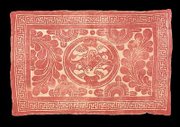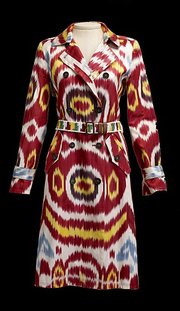To Dye For in San Francisco
This "Woman's chapan robe, ca. 1860–1870; Uzbekistan, Bukhara Silk; warp-faced plain weave, warp-resist dyeing (ikat)" will be on display at the "To Dye For" exhibit at the de Young Museum in San Francisco. Photo courtesy de Young Museum.
Rubber-banded and dipped in a bucket hippie T-shirts, these are not. Opening on July 31 at The Fine Arts Museums of San Francisco’s de Young Museum is “To Dye For,” an exhibit of awe-inspiring historical textiles from times and places before the advent of electricity-powered machines.
Speaking to the nitty-gritty textile nerds, the exhibit will not just cover tie-dye, but all forms of resist-dye methods, such as stitch-resist, batik, wax-resist dying, stencil-resist, mordant-resist and ikat, among others.
The descriptions of the items that will be on display are mind-boggling in their specificity and foreignness of land—a tie-dyed tunic from the Wari-Nasca culture of pre-Hispanic Peru, dated A.D. 500-900, and stitch-resist dyed 20th century kerchiefs from the Dida people of the Ivory Coast—which means the sight of these textile artifacts is sure to haunt your memory so deeply that those fun batik pillows at Anthropologie you used to think were cute will now look like chintzy, amateur rubbish.
A few pieces from present day are thrown in to show how modern designers use these centuries-old techniques, including a tie-dye evening gown from Rodarte’s 2009 collection and an ikat trench coat from Oscar de La Renta’s 2005 collection. Visit deyoung.famsf.org for more info.
Oscar de la Renta Trench coat, 2005. Silk; warp-faced plain weave, warp-resist dyeing (ikat). Photo courtesy de Young Museum.
Felt rug, 15th - 17th century. Mongolia. Wool; felt, stencil-resist dyed. Photo courtesy de Young Museum.
























